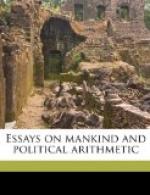[The columns for the table are: Number of person; Males; Females; Remarried Persons; Persons under 16 years old; Persons above 60 years old; Protestants of above 16 years old; Papists of above 16 years old; Of all other religions above 16 years old; Births; Burials; Marriages. In the book there are no figures in the table at all.—DP.]
Casualties and diseases.
Aged above 70 years Epilepsy and planet
Abortive and still-born Fever and ague
Childbed women Pleurisy
Convulsion Quinsy
Teeth Executed, murdered,
Worms drowned
Gout and sciatica Plague and spotted fever
Stone Griping of the guts
Palsy Scouring, vomiting
Consumption and French bleeding
pox
Small pox
Dropsy and tympany Measles
Rickets and livergrown Neither of all the other
Headache and megrim sorts
A POSTSCRIPT TO THE STATIONER.
Whereas you complain that these observations make no sufficient bulk, I could answer you that I wish the bulk of all books were less; but do nevertheless comply with you in adding what follows, viz.:
1. That the parishes of Dublin are very unequal; some having in them above 600 families, and others under thirty.
2. That thirteen parishes are too few for 4,000 families; the middling parishes of London containing 120 families; according to which rate there should be about thirty-three parishes in Dublin.
3. It is said that there are 84,000 houses or families in London, which is twenty-one times more than are in Dublin, and yet the births and burials of London are but twelve times those of Dublin, which shows that the inhabitants of Dublin are more crowded and straitened in their housing than those of London; and consequently that to increase the buildings of Dublin will make that city more conformable to London.
4. I shall also add some reasons for altering the present forms of the Dublin bills of mortality, according to what hath been here recommended—viz.:
1. We give the distinctions of males and females in the births only; for that the burials must, at one time or another, be in the same proportion with the births.
2. We do in the weekly and quarterly bills propose that notice be taken in the burials of what numbers die above sixty and seventy, and what under sixteen, six, and two years old, foreseeing good uses to be made of that distinction.




